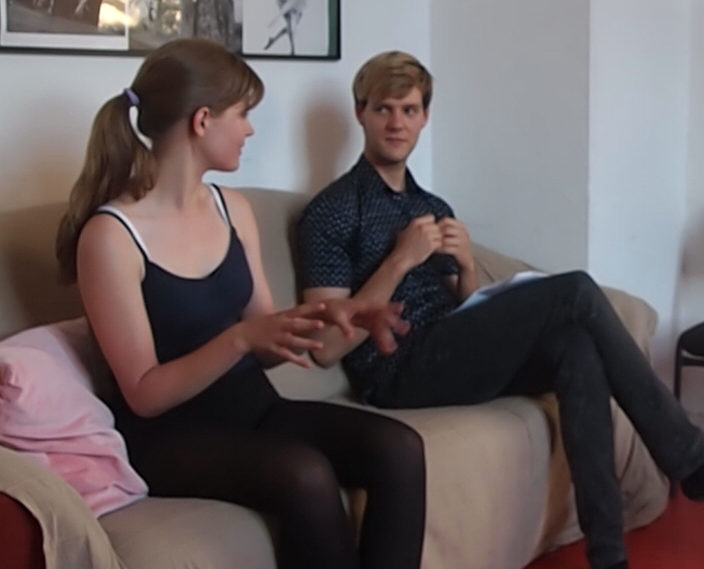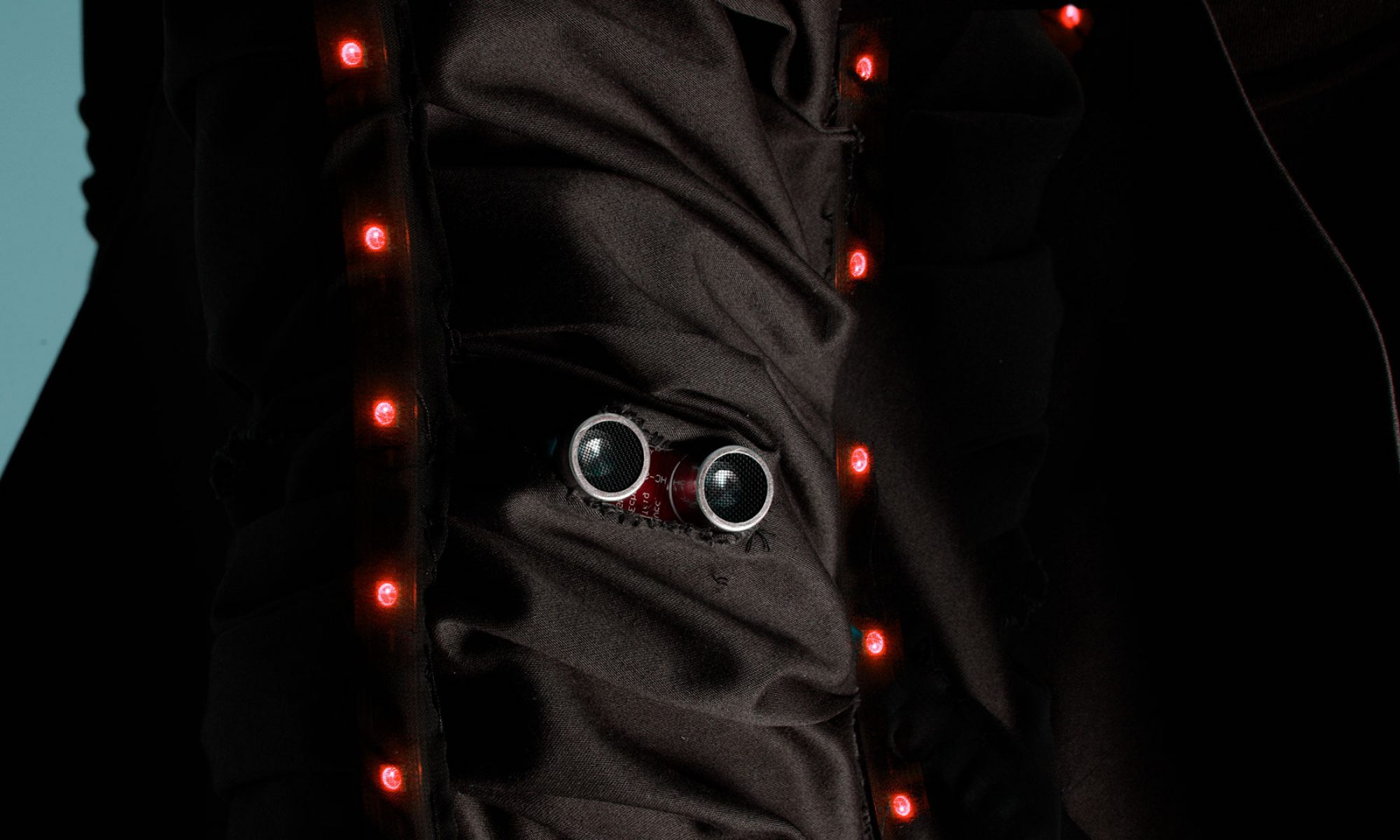The semi-structured interview with our dancer, who tested the prototype first, confirmed some of our opinions about the costume and gave us also a few new contrasting insights.

One dancer wore the costume and danced three dances with it. One solo performance with just headphone music as guidance, once in the group with background music and once she did the choreography from her head.
The dancer talked in the interview mostly around the two distinct characteristics of the costume: knitted and sound. From the transcript we color coded the responses and grouped them into the categories of our research question proposals. In the following the most important quotes from the test dancer and from the general discussion, which sometimes also carry over into other categories:
Usability:
“I don’t know if it was because I wore the costume the first time, but because of these fibres I was a little careful, also because of this technology in the back.”
“I think I could put it on myself, but this time I didn’t want to break it.”
“I could not raise my arm all the way up and I did not want to force it.”
“But if more than one dancer has the costume and they are not perfectly synchronous, you can hear that easier, especially because we are not so professional yet.”
Wearability:
“I liked that I could move very freely.”
“It followed the movements, did not disturb.”
“I did not like that it got extremely warm. [..] If I had to dance for two hours, and the headlights were on. [..] It would get uncomfortable.”
“Maybe not from wool, so that you feel comfortable to spend more time in it and explore it.”
Effect:
“Reminds me of such very modern fashion that you see on shows, very abstract.”
“I would say cool, because with the wool it is different and something completely new.”
“I am not sure how well it works on the big stage. The wool is all black and has many details. [..] This you maybe cannot see from far [..] It might look like a wool hank.”
“The costumes are all very futuristic, […] they fit mostly the modern dance as you don’t always have a tutu and some of the dances are silent or they explore with breathing. “
“The knitted suit was very puristic and if you imagine that these things on the side would grow even more, as you said, that transports an interesting message. “
Sound:
“It influences other senses than the visual one, this you don’t have yet with dance. It brings a new dimension.”
“In the beginning I could not hear so much influence [..] but when I got down with my knees I could hear it with the headphones on.”
“The dance I did is actually quite happy but the sound from the costume is not, maybe something more melodic [..] or for a different character, a powerful one.”
“I did not expect that It would make these constant sounds, like from an akkordeon. Later it also made other noises.”
“Sound is something from the future. It could be great to hear a whole dance. “
“It would be great for blind people.”
Choreography:
“Maybe some dance with maximum movements, just fit to the costume and its sounds. A choreography with only sounds from costumes would be great, so that you as a dancer create the music yourself”.
“I think multiple different costumes would sound great.”
“It is not easy to integrate into existing choreographies, you need a muted dance that is developed just for the costume, but it would be an interesting approach. Would it actually be possible to have melodic sounds or other sounds with the costumes?”
Interpretation
Usability: The costume can creates new challenges for dancers.
Wearability: The costume is flexible but too warm.
Effect: The look of the costume is suited for dance.
Sound: The sound should be more direct and friendly for this choreography.
Choreography: It needs its own choreography to show the full potential.
The general impression about the costume seems positive. The time the dancer had with the costume was very short and the costume was not tested with an audience which is why some of the very interesting questions the sonification costumes rises will be left unanswered. However our one dancer and the dance teacher reported that costumes that create sound are something very interesting that should be worked with. It is not just for blind people but adds a whole new dimension that choreographers might be very interested in.
We found that such a costume is not something for amateurs as the sounds and choreography need to be adjusted hand in hand if the costume should just not be an instrument that creates arbitrary noises. From the point of view of the dancer the negative thing about the costume is that it is too hot to dance in. Even if the dancer tested it on a particularly hot summer day traditional spotlights also create a lot of heat in winter.
Our opinions is that the costume shows that sensors can be integrated into the strings of fabric but it must be made professionally with a machine so that other fibres can be used that are more suitable. On the other hand such a knitted costume might fit more into theater where characters do not move as much. Obviously the set up with the computer and speaker takes time but this time can be scheduled before a performance.
Such a costume (and all interactive costumes) cannot just be hand over to dancers without readjusting choreographies as it changes the meaning of a dance and the importance of the dancer. We suggest to create interactive costumes that are specifically suited for training: washable, light, robust, easy to repair, comfortable, easy to put on and easy to maintain. This is the only option for choreographers and dancers to create a choreography specific for the costume, which should be worn only during the performance.
Furthermore we conclude that not all characteristics of an interactive costume can be optimized. Functionality, usability, wearability, effect and integration do not go completely hand in hand and the dancers, choreographers and tailors have to balance their preferences.
Appendix
For the possible research questions we can give tendencies that occurred during the interview and the test dance.
FUNCTIONALITY
Is the costume interactive? Does it react to the user’s input? Yes.
How good is the concept realized in the costume?
Is the sensor appropriate to notice the desired information/data? Did not give enough range yet.
Can the system design (software/hardware) be improved? Yes. From the interview findings mostly the material should be changed or the choreography (slow dances). The sensors need to be improved and the sound needs to be adjusted for a certain choreography.
Does it work reliable amongst different wearers?
How easy/difficult is maintaining (e.g. charging batteries, repair cable breaks) the costume? How many technical support needs the costume through its creators? Difficult
USABILITY
How easy/difficult is it to use/start the costume’s functions? Is it possible without the creator’s help? Putting on the costume is easy with some help but starting and installing the software needs a technician.
Are the technical features intuitive to the wearers? Yes.
Do different wearers use the costume differently?
Does the dancer realize how the costume reacts to him/her? Yes, but not aware of the technical realization (thought it works with pressure sensors)
Does the output distract the dancer? No, because dancers have to know their choreography by hard. Can be problematic to synchronize dancers.
Are there any constraints? Yes. -> Not washable, difficult to set up.
Is it possible for the users (dancer, choreographer, dresser, tailor, …) to maintain (e.g. cleaning) the costume independently? How many support is needed by the creators? Not yet, depends if there is a technician who knows a few things about computers.
WEARABILITY
Does the wearer feel comfortable? It is cozy but warm.
What exactly feels good what less comfortable while wearing the costume? Movement is almost unrestricted but heat accumulates.
How easy is (un-)dressing the costume? Relatively easy. Some help so that nothing gets broken is needed.
How easy is it to make shape changes (e.g. adapt size to different wearers) in-house without the support of the creators? Impossible.
EFFECT
What is the users’ and stakeholders’ (dancer, choreographer, dresser, tailor, …) perception of the costume? How do they perceive the interactive effects? Not asked in depth, but tendency for a warmer more friendly sound among the young dancers.
Is there a difference in the subjective perception of different users or stakeholders?
Are the tech features understandable? The abstract overview can be understood.
Does the costume causes emotions? If yes, what kind of?
Can the costume potentially add something (new) to a performance, and if yes, why? Yes, is seen as very new and futuristic. The different sensory element is described as very interesting.
INTEGRATION
Does the costume enhance the medium dance, and if yes, how? Yes, new dimension in dance, new look.
How do dancers adapt to this type of costume in comparison to traditional dance costumes?
How much more rehearsal time is needed when using interactive costumes in dance?
How well/ less acceptable do existing choreographies work with the costume? How easy/ difficult is it to develop a new choreography with the costume? Not well, or the influence of the costume on the aesthetic/perception of the dance is very high and it changes its meaning.
